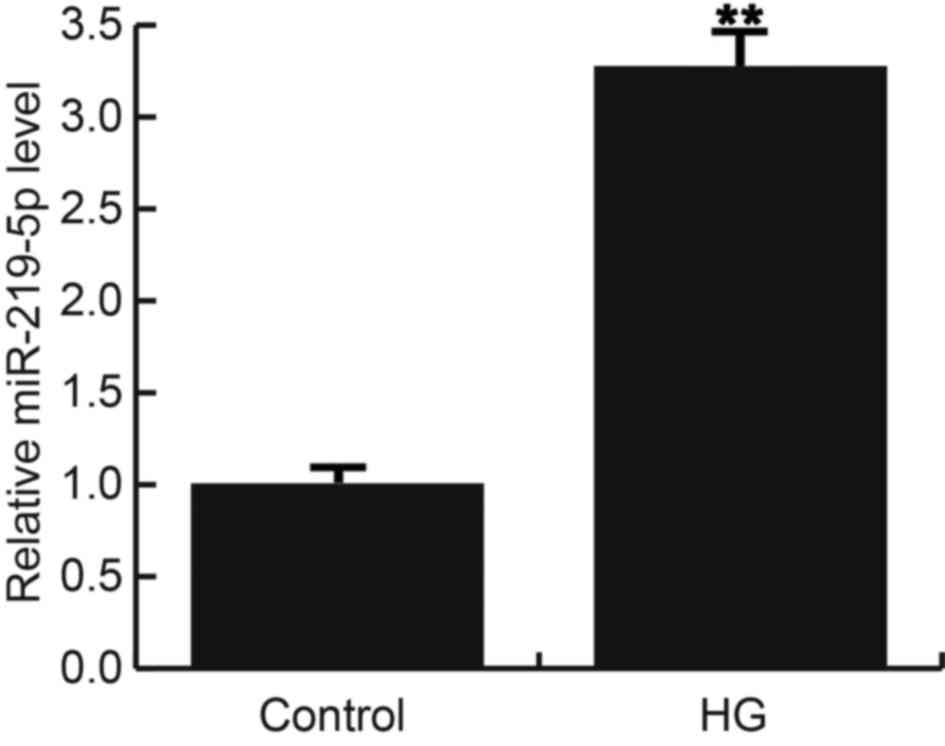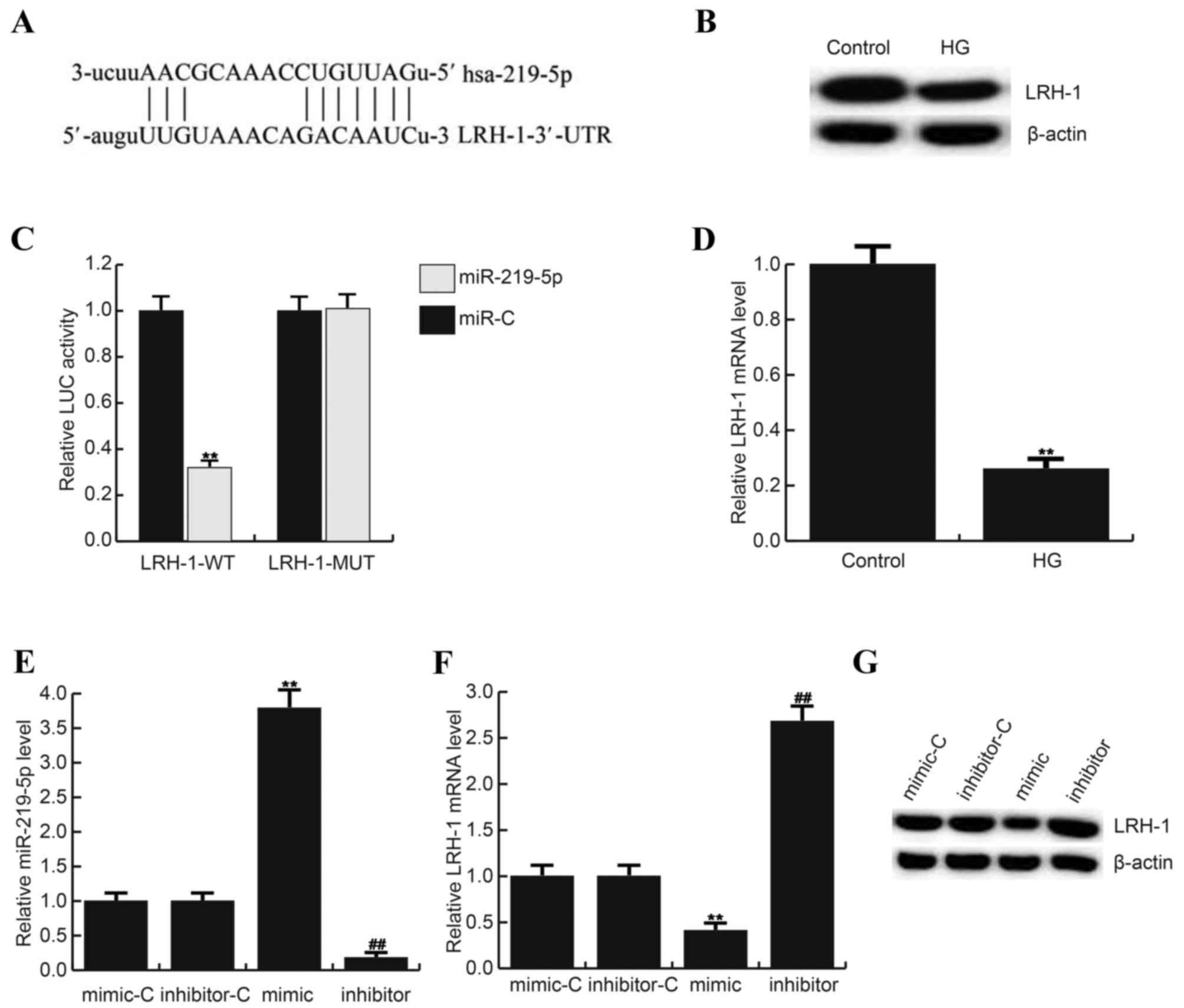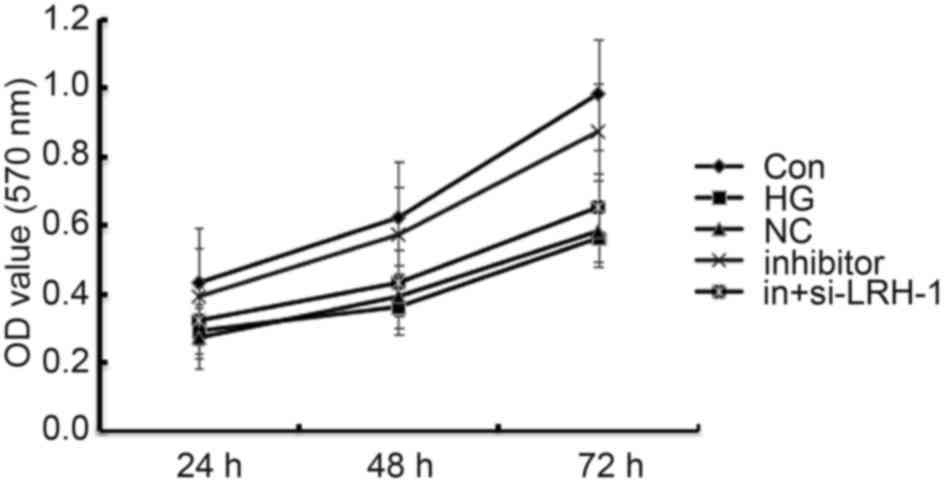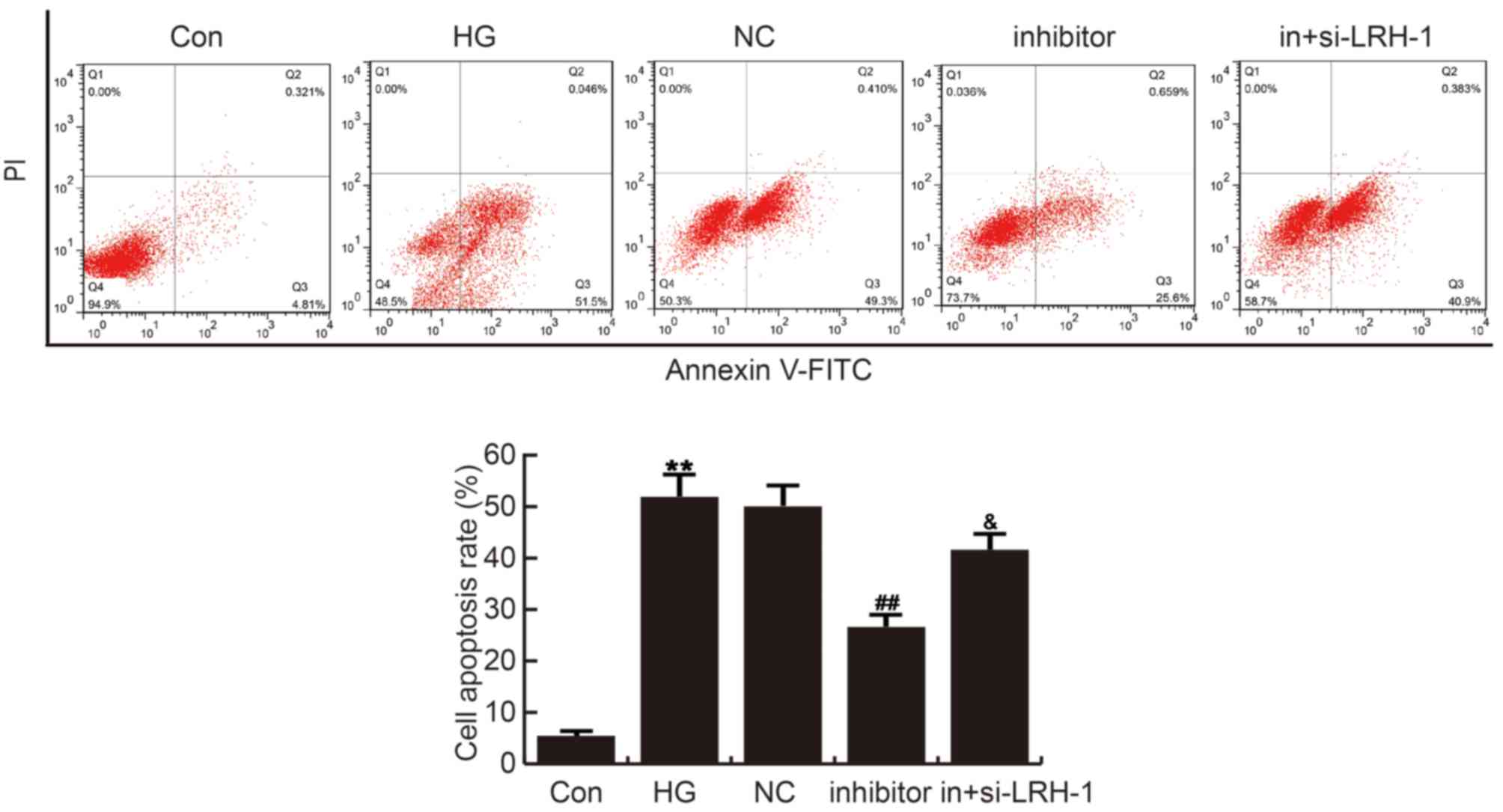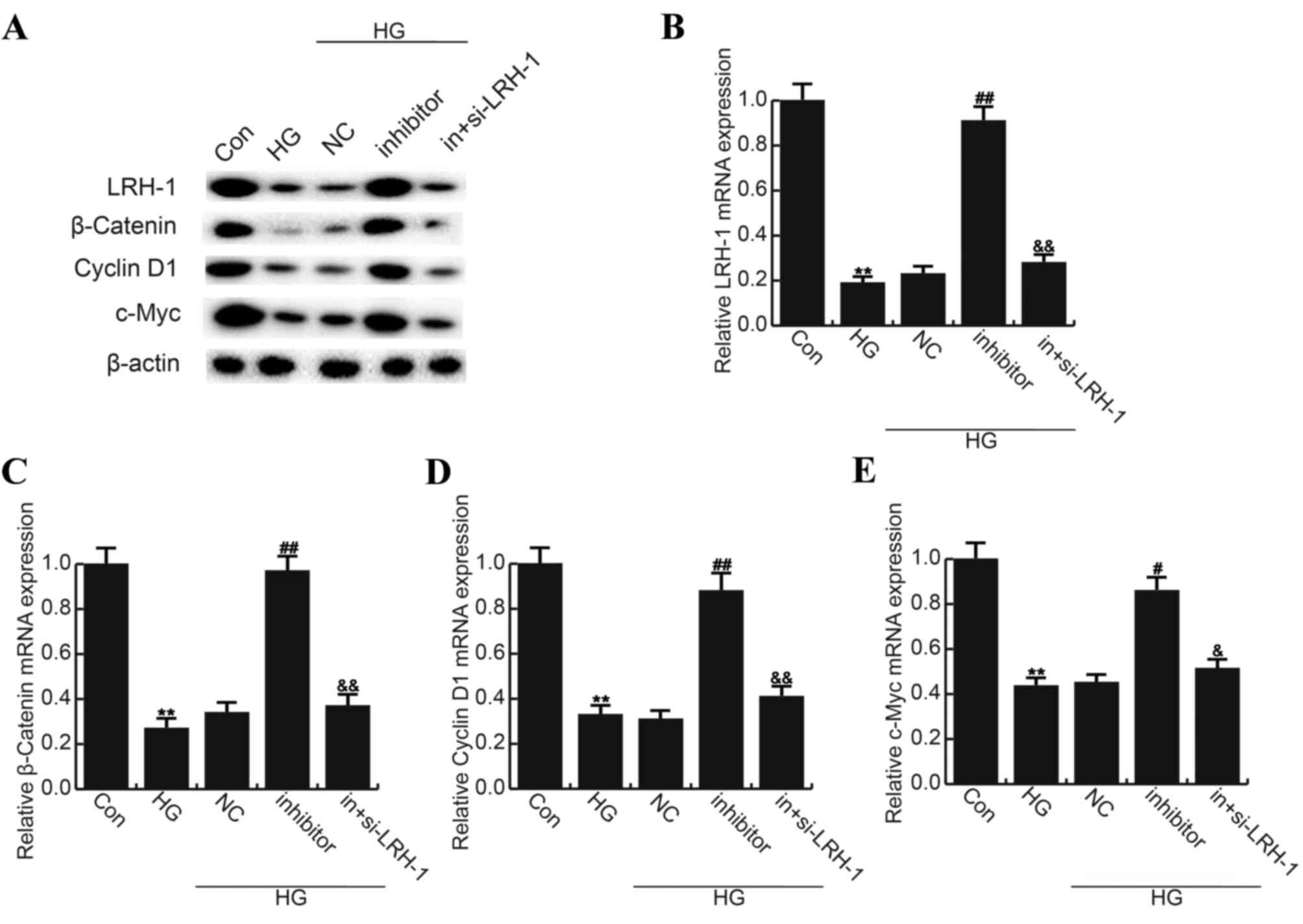Significant role of microRNA‑219‑5p in diabetic retinopathy and its mechanism of action
- Authors:
- Published online on: May 8, 2018 https://doi.org/10.3892/mmr.2018.8988
- Pages: 385-390
Abstract
Introduction
Diabetic retinopathy (DR), one of the most common complications of diabetes, is the leading cause of blindness and visual impairment in the working population (25–65 years old) in developing countries (1). As a kind of fundus lesions with specific changes, the pathology of DR is retinal micro-vascular dysfunction, and its clinical features are mainly manifestations of capillary periocular cell reduction, basement membrane thickening, abnormal proliferation of endothelial cells and angiogenesis, leading to macular edema, vitreous hemorrhage, retinal detachment and other serious injuries (2). At present, the treatment of DR is mainly through retinal photocoagulation and vitreous surgery, but the visual function of most patients has been already irreversibly damaged before the treatment. So far, DR is still lack of effective prevention and treatment. Therefore, seeking for new effective diagnosis and treatment methods has been a hot issue in the study of DR.
MicroRNAs (MiRNAs), a class of non-coding single-stranded small RNA, about 18–24 nucleotides in length, can transcriptionally or post-transcriptionally regulate the expression of the target genes by specific binding to the 3′-UTR of target mRNAs (3–5). MiRNAs play an important regulatory role in the process of visual function formation via involving in regulation of the physiological processes such as ocular development, neural differentiation, functional maintenance and apoptosis. Kovacs et al (6), have confirmed for the first time that the miRNAs expression profile has changed during DR. MiR-29 has been found to play important roles in the process of high glucose (HG) induced apoptosis in RPE cells, thus involved in DR progress (7). MiR-20b plays critical role in DR by targeting protein kinase B-3 (AKT3) (8). MiRNA-29a could down-regulate the expression of angiotensinogen (AGT), thereby repressing the development of DR (9). Moreover, miR-200b has been reported might alleviate DR development via the down-regulation of its target gene vascular endothelial growth factor A (VEGFA) (10).
MiR-219-5p, a tumor suppressor in a variety of cancers, may play an important role in regulating cell growth and apoptosis (11–14). So far, the expression and role of miR-219-5p in DR remain unclear. Therefore, the present study aimed to investigate the role of miR-219-5p in the development of DR, and to explore the underlying molecular mechanism.
Materials and methods
Cell culture
The human retinal pigment epithelial (RPE) cell line ARPE-19 was obtained from the American Type Culture Collection (ATCC, Manassas, VA). Cells were cultured in DMEM/F-12 medium (Gibco; Thermo Fisher Scientific, Inc., Waltham, MA, USA) containing HG (25 mM D-glucose) or normal glucose (control, 5 mM D-glucose) (15,16), 10% fetal bovine serum (FBS; Gibco; Thermo Fisher Scientific, Inc.), 2 mM L-glutamine (Sigma-Aldrich; Merck KGaA, Darmstadt, Germany), 100 µg/ml streptomycin, and 100 units/ml penicillin (Sigma-Aldrich; Merck KGaA), and incubated at 37°C with 5% CO2. The cells were passaged until reaching 80~90% confluence.
Cell transfection
The day before cell transfection, ARPE-19 cells were seeded into a 6-well plate at the concentration of 5×104 cells per well and cultured in a incubator at 37°C with 5% CO2. Then the ARPE-19 cells were transfected with miR-219-5p inhibitor, its negative control, or miR-219-5p inhibitor+LRH-1-siRNA with 30 µl Lipofectamine 2000 (Invitrogen; Thermo Fisher Scientific, Inc.) according to the manufacturer's protocol. Cells without any treatment were recognized as the control group. These cells were initially transfected for 6 h, then the culture medium was replaced with DMEM/F-12 medium containing 50 mM HG (7). After incubation for 24 h, the cells were subjected to following experiments.
Cell viability assay
Twenty four hours after treatment, cell viability assay was used to measure the cell viability. Briefly, ARPE-19 cells were trypsinized, re-suspended, and then reseeded into 96-well plates and incubated at 37°C for 24, 48 and 72 h respectively. Subsequently, 20 mg/ml MTT solution (Sigma-Aldrich; Merck KGaA) was added into each well and then incubated for another 4 h. At the end of the experiment, the optical density (OD) value at 570 nm was detected by using a SynergyTM 2 Multi-function Microplate Reader (Bio-Tek Instruments, Inc., Winooski, VT, USA). Tests were repeated at least for three times.
Cell apoptosis assay
To analyze cell apoptosis, cell apoptosis assay was performed using flow cytometry (BD Biosciences, Franklin Lakes, NJ, USA). 24 h after treatment, ARPE-19 cells were stained with annexin V-FITC and propidium iodide (PI) (CST Biological Reagents Co., Ltd., Shanghai, China) in line with the manufacturer's instructions. Finally, we used flow cytometry to analyze cell apoptosis. Tests were repeated at least for three times.
RNA extraction and quantitative RT-PCR
Total RNA was extracted from ARPE-19 cells by using TRIZOL reagent (Invitrogen; Thermo Fisher Scientific, Inc.) following the manufacturer's protocol. The total RNA was reversely transcripted into cDNA using a PrimeScript reverse transcription reagent kit (Takara Biotechnology Co., Ltd., Dalian, China). Subsequently, TaqMan Universal PCR Master Mix kit (Thermo Fisher Scientific, Inc.) was performed to analyze the synthesized cDNAs. The amplification conditions were as follows: 95°C for 10 min, followed by 40 cycles of 95°C for 10 sec and 57°C for 60 sec. All primer sequences were obtained from Genscript (Nanjing, China), and the relative gene expression was analyzed by using the 2−ΔΔCq method (17).
Western blot analysis
After treatment for 24 h, ARPE-19 cells were harvested by microcentrifugation. Total cell protein was extracted using the lysis buffer (Promega Corporation, Madison, WI, USA). Equal amount of the samples were separated by SDS-polyacrylamide gel electrophoresis and then transferred onto an enhanced nitrocellulose membrane. Blots were blocked with 5% skim milk at room temperature for 2 h, incubated with the primary antibody against LRH-1 (cat no. 12800), β-catenin (cat no. 8480), Cyclin D1 (cat no. 2978), c-Myc (cat no. 13978) (all dilution: 1:1,000) and β-actin (cat no. 4970; dilution: 1:5,000) (dilution: 1:1,000; all from Cell Signaling Technology, Danvers, MA, USA) at 4°C overnight, and then incubated with a secondary antibody at room temperature for 2 h. At the end of the test, blots were observed by using the enhanced chemiluminescence detection system (Super Signal West Dura Extended Duration Substrate; Pierce; Thermo Fisher Scientific, Inc.).
Dual-luciferase reporter assay
We used bioinformatics software (http://www.microrna.Org/microrna/home.do) to predict the promising targets of miR-219-5p, and we found that LRH-1 was potentially targeted by miR-219-5p. In order to confirm our prediction, dual-luciferase reporter assay was applied. In brief, the 3′UTR of LRH-1 gene, which includes the miR-219-5p binding domain, was sub-cloned into the XhoI and NotI sites of a psiCHECK2 luciferase vector (Promega Corporation) (LRH-1 WT). To point-mutate the miR-219-5p binding domain on the 3′UTR of LRH-1, a QuikChange Site-Directed Mutagenesis kit (Agilent Technologies, Inc., Santa Clara, CA, USA) was performed according to the manufacturer's instructions. Then the mutated LRH-1 3′UTR was sub-cloned into psiCHECK2 luciferase vector (LRH-1 MUT). ARPE-19 cells were co-transfected with LRH-1 WT or LRH-1 MUT and miR-219-5p mimic or miR-control (control of miR-219-5p mimic). 48 h later, the dual-luciferase reporter assay system (Promega Corporation) was carried out to determine the luciferase activity.
Statistical analysis
SPSS v16.0 statistical software (SPSS, Inc., Chicago, IL, United States) was applied for all statistical analyses. Data were presented as the mean ± SD. Comparison between two groups were made by Student's t-test, between multiple groups by one-way ANOVA followed by Tukey's test. P<0.05 was considered to indicate a statistically significant difference.
Results
MiR-219-5p was up-regulated in HG treated ARPE-19 cells
In current study, we firstly treated ARPE-19 cells with 50 mM D-glucose or 0 mM D-glucose (control). Consistent with a previous study, significant apoptosis in ARPE-19 cells was induced after treatment with 50 mM D-glucose, as compared to the control group with 0 mM D-glucose. 24 h after treatment, miR-219-5p was detected using qRT-PCR, and the results indicated that compared with the control cells, miR-219-5p expression was significantly up-regulated in HG treated ARPE-19 cells (Fig. 1).
MiR-219-5p directly targets LRH-1
Bioinformatics software (http://www.microrna.Org/microrna/home.do) was performed to predict the targets of miR-219-5p. About 4000 targets were found to be potentially targeted by miR-219-5p, including LRH-1 (Fig. 2A). LRH-1 has been revealed to play an important role in the regulation of cell proliferation and apoptosis via controlling the Wnt/β-catenin signaling pathways (12,18). However, whether LRH-1 functions its role in DR is still unclear. Therefore, we choose LRH-1 to make further investigation. And the results of dual-luciferase reporter assay indicated that miR-219-5p directly targets LRH-1 at 3′UTR domain (Fig. 2B). And the lower expression of LRH-1 in HG treated ARPE-19 cells was observed in the current study (Fig. 2C and D).
Then we determined whether miR-219-5p regulates LRH-1 expression in ARPE-19 cells, miR-219-5p mimic, mimic control, miR-219-5p inhibitor or inhibitor control was transfected into ARPE-19 cells, and the transfection efficiency was assessed by qRT-PCR (Fig. 2E). The findings suggested that miR-219-5p mimic significantly decreased both mRNA (Fig. 2F) and protein (Fig. 2G) level of LRH-1 (55 kD) in ARPE-19 cells, while miR-219-5p inhibitor presented the opposite effects.
MiR-219-5p inhibitor promoted ARPE-19 cell viability
Influence of miR-219-5p inhibitor on ARPE-19 cell activity was detected using MTT assay. Compared with the control group, the viability of ARPE-19 cell seriously reduced in the HG group, and the declined cell viability was rescued by miR-219-5p inhibitor. In addition, LRH-1-siRNA eliminated the enhanced cell viability caused by miR-219-5p inhibitor (Fig. 3).
MiR-219-5p inhibitor repressed HG induced ARPE-19 cell apoptosis
The effects of miR-219-5p inhibitor on ARPE-19 cell apoptosis was analyzed by cell apoptosis assay with FCM. Compared with the control group, ARPE-19 cell apoptosis was significantly induced in HG group, which was repressed by miR-219-5p inhibitor administration. These changes caused by miR-219-5p inhibitor were eliminated by LRH-1-siRNA (Fig. 4).
MiR-219-5p inhibitor rescued the LRH-1/Wnt/β-Catenin inhibition caused by HG
Finally, in order to explore the underlying molecular mechanism of the role miR-219-5p played in DR process, LRH-1/Wnt/β-Catenin pathway was analyzed, and western blotting and qRT-PCR was performed respectively. As shown in Fig. 5, compared with the control group, the level of LRH-1 (55 kD), β-Catenin (92 kD), Cyclin D1 (36 kD) and c-Myc (62 kD) significantly reduced in HG treated ARPE-19 cells, and miR-219-5p inhibitor markedly enhanced LRH-1, β-Catenin, Cyclin D1 and c-Myc expression when compared to the HG group. LRH-1 gene silencing eliminated the effects caused by miR-219-5p inhibitor (Fig. 5).
Discussion
Irreversible damage of the blood-retina barrier (BRB) may caused by hyperglycemia or HG, resulting in loss of vision or blindness, during DR (19). Hyperglycemia or HG induced apoptosis in RPE cells, the essential elements of BRB, is a characteristic process in DR (20). Increasing evidences have suggested a regulatory function and the potential influences of microRNAs in DR treatment. MiR-219-5p has been reported as a tumor suppressor in a large number of cancers via the regulation of cell migration, invasion, proliferation and apoptosis (11–14,21). However, the regulation of cell apoptosis by miR-219-5p on human RPE cells remains unclear. The present study aimed to investigate the expression of miR-219-5p in human RPE cells, and to further explore its role in regulating human RPE cell apoptosis under HG conditions.
According a precious study, 50 mM D-glucose could significantly induced human RPE cell apoptosis (7). Firstly, we examined the level of miR-219-5p in human RPE cells after treatment with 50 mM D-glucose for 24 h, and the findings suggested that miR-219-5p was significantly up-regulated, indicating miR-219-5p may be involved in the process of DR. Then we found that about 4000 targets may be targeted by miR-219-5p, including LRH-1. LRH-1 (liver receptor homologue-1), also called NR5A2, is a member of the nuclear receptor subfamily which is involved in various biological processes, including differentiation, steroid synthesis, and bile-acid homeostasis, etc (22–24). Recently, a large number of studies have revealed that LRH-1 plays a key role in regulating cell growth, including apoptosis (12,18,25–28). Due to its unclear role in DR, LRH-1 was further explored in the present study. Our results indicated that LRH-1 was a direct target of miR-219-5p, and LRH-1 was lower expressed in HG treated human RPE cells compared to the control cells. Moreover, our findings showed that LRH-1 was negatively regulated by miR-219-5p in human RPE cells. These findings suggested that miR-219-5p may participate in the development of DR by targeting LRH-1.
To study the role and molecular mechanism of miR-219-5p in DR, we determined the effect of miR-219-5p inhibitor on human RPE cell viability and cell apoptosis, and we found that miR-219-5p inhibitor notably promoted human RPE cell viability which was inhibited by HG treatment, and repressed HG induced human RPE cell apoptosis. LRH-1/Wnt/β-Catenin pathway was inhibited in human RPE cells after HG treatment, and this inhibition was rescued by miR-219-5p inhibition. In addition, we revealed that the effects of miR-219-5p inhibitor on human RPE cells could be eliminated by LRH-1-siRNA under HG condition.
In summary, our study demonstrated that HG resulted in the up-regulation of miR-219-5p expression in human RPE cells. MiR-219-5p down-regulation promoted human RPE cell viability and inhibited cell apoptosis through regulating LRH-1/Wnt/β-Catenin pathway by targeting LRH-1. MiR-219-5p/LRH-1 may be promising therapeutic targets for DR.
Competing interests
The authors declare that they have no competing interests.
References
|
Ding J and Wong TY: Current epidemiology of diabetic retinopathy and diabetic macular edema. Curr Diab Rep. 12:346–354. 2012. View Article : Google Scholar : PubMed/NCBI | |
|
Yau JW, Rogers SL, Kawasaki R, Lamoureux EL, Kowalski JW, Bek T, Chen SJ, Dekker JM, Fletcher A, Grauslund J, et al: Global prevalence and major risk facers of diabetic retinopathy. Diabetes Care. 35:556–564. 2012. View Article : Google Scholar : PubMed/NCBI | |
|
Kim VN, Han J and Siomi MC: Biogenesis of small RNAs in animals. Nat Rev Mol Cell Biol. 10:126–139. 2009. View Article : Google Scholar : PubMed/NCBI | |
|
Bartel DP: MicroRNAs: Target recognition and regulatory functions. Cell. 136:215–233. 2009. View Article : Google Scholar : PubMed/NCBI | |
|
Valencia-Sanchez MA, Liu J, Hannon GJ and Parker R: Control of translation and mRNA degradation by miRNAs and siRNAs. Genes Dev. 20:515–524. 2006. View Article : Google Scholar : PubMed/NCBI | |
|
Kovacs B, Lumayag S, Cowan C and Xu S: MicroRNAs in early diabetic retinopathy in streptozotocin-induced diabetic rats. Invest Ophthalmol Vis Sci. 52:4402–4409. 2011. View Article : Google Scholar : PubMed/NCBI | |
|
Lin X, Zhou X, Liu D, Yun L, Zhang L, Chen X, Chai Q and Li L: MicroRNA-29 regulates high-glucose-induced apoptosis in human retinal pigment epithelial cells through PTEN. In Vitro Cell Dev Biol Anim. 52:419–426. 2016. View Article : Google Scholar : PubMed/NCBI | |
|
Qin B, Liu J, Liu S, Li B and Ren J: MiR-20b targets AKT3 and modulates vascular endothelial growth factor-mediated changes in diabetic retinopathy. Acta Biochim Biophys Sin (Shanghai). 48:732–740. 2016. View Article : Google Scholar : PubMed/NCBI | |
|
Zhang LQ, Cui H, Wang L, Fang X and Su S: Role of microRNA-29a in the development of diabetic retinopathy by targeting AGT gene in a rat model. Exp Mol Pathol. 102:296–302. 2017. View Article : Google Scholar : PubMed/NCBI | |
|
Li EH, Huang QZ, Li GC, Xiang ZY and Zhang X: Effects of miRNA-200b on the development of diabetic retinopathy by targeting VEGFA gene. Biosci Rep. 37:pii: BSR20160572. 2017. View Article : Google Scholar | |
|
Wang Q, Zhu L, Jiang Y, Xu J, Wang F and He Z: miR-219-5p suppresses the proliferation and invasion of colorectal cancer cells by targeting calcyphosin. Oncol Lett. 13:1319–1324. 2017. View Article : Google Scholar : PubMed/NCBI | |
|
Li C, Dong J, Han Z and Zhang K: MicroRNA-219-5p represses the proliferation, migration, and invasion of gastric cancer cells by targeting the LRH-1/Wnt/β-catenin signaling pathway. Oncol Res. 25:617–627. 2017. View Article : Google Scholar : PubMed/NCBI | |
|
Huang C, Cai Z, Huang M, Mao C, Zhang Q, Lin Y, Zhang X, Tang B, Chen Y, Wang X, et al: miR-219-5p modulates cell growth of papillary thyroid carcinoma by targeting estrogen receptor α. J Clin Endocrinol Metab. 100:E204–E213. 2015. View Article : Google Scholar : PubMed/NCBI | |
|
Huang N, Lin J, Ruan J, Su N, Qing R, Liu F, He B, Lv C, Zheng D and Luo R: MiR-219-5p inhibits hepatocellular carcinoma cell proliferation by targeting glypican-3. FEBS Lett. 586:884–891. 2012. View Article : Google Scholar : PubMed/NCBI | |
|
Ruiz MA, Feng B and Chakrabarti S: Polycomb repressive complex 2 regulates MiR-200b in retinal endothelial cells: Potential relevance in diabetic retinopathy. PLoS One. 10:e01239872015. View Article : Google Scholar : PubMed/NCBI | |
|
Zhao S, Li T, Li J, Lu Q, Han C, Wang N, Qiu Q, Cao H, Xu X, Chen H and Zheng Z: miR-23b 3p induces the cellular metabolic memory of high glucose in diabetic retinopathy through a SIRT1-dependent signalling pathway. Diabetologia. 59:644–654. 2016. View Article : Google Scholar : PubMed/NCBI | |
|
Livak KJ and Schmittgen TD: Analysis of relative gene expression data using real-time quantitative PCR and the 2(-Delta Delta C(T)) method. Methods. 25:402–408. 2001. View Article : Google Scholar : PubMed/NCBI | |
|
Zhai G, Song J, Shu T, Yan J, Jin X, He J and Yin Z: LRH-1 senses signaling from phosphatidylcholine to regulate the expansion growth of digestive organs via synergy with Wnt/β-catenin signaling in zebrafish. J Genet Genomics. 44:307–317. 2017. View Article : Google Scholar : PubMed/NCBI | |
|
Ahsan H: Diabetic retinopathy-biomolecules and multiple pathophysiology. Diabetes Metab Syndr. 9:51–54. 2015. View Article : Google Scholar : PubMed/NCBI | |
|
Simó R, Villarroel M, Corraliza L, Hernández C and Garcia-Ramírez M: The retinal pigment epithelium: Something more than a constituent of the blood-retinal barrier-implications for the pathogenesis of diabetic retinopathy. J Biomed Biotechnol. 2010:1907242010. View Article : Google Scholar : PubMed/NCBI | |
|
Cheng J, Deng R, Zhang P, Wu C, Wu K, Shi L, Liu X, Bai J, Deng M, Shuai X, et al: miR-219-5p plays a tumor suppressive role in colon cancer by targeting oncogene Sall4. Oncol Rep. 34:1923–1932. 2015. View Article : Google Scholar : PubMed/NCBI | |
|
Sablin EP, Blind RD, Uthayaruban R, Chiu HJ, Deacon AM, Das D, Ingraham HA and Fletterick RJ: Structure of liver receptor homolog-1 (NR5A2) with PIP3 hormone bound in the ligand binding pocket. J Struct Biol. 192:342–348. 2015. View Article : Google Scholar : PubMed/NCBI | |
|
Fayard E, Auwerx J and Schoonjans K: LRH-1: An orphan nuclear receptor involved in development, metabolism and steroidogenesis. Trends Cell Biol. 14:250–260. 2004. View Article : Google Scholar : PubMed/NCBI | |
|
Stein S and Schoonjans K: Molecular basis for the regulation of the nuclear receptor LRH-1. Curr Opin Cell Biol. 33:26–34. 2015. View Article : Google Scholar : PubMed/NCBI | |
|
Zhang Q, Zhao S, Pang X and Chi B: MicroRNA-381 suppresses cell growth and invasion by targeting the liver receptor homolog-1 in hepatocellular carcinoma. Oncol Rep. 35:1831–1840. 2016. View Article : Google Scholar : PubMed/NCBI | |
|
Jiang W, Tian Y, Jiang S, Liu S, Zhao X and Tian D: MicroRNA-376c suppresses non-small-cell lung cancer cell growth and invasion by targeting LRH-1-mediated Wnt signaling pathway. Biochem Biophys Res Commun. 473:980–986. 2016. View Article : Google Scholar : PubMed/NCBI | |
|
Baquié M, St-Onge L, Kerr-Conte J, Cobo-Vuilleumier N, Lorenzo PI, Moreno Jimenez CM, Cederroth CR, Nef S, Borot S, Bosco D, et al: The liver receptor homolog-1 (LRH-1) is expressed in human islets and protects {beta}-cells against stress-induced apoptosis. Hum Mol Genet. 20:2823–2833. 2011. View Article : Google Scholar : PubMed/NCBI | |
|
Wang S, Lan F, Huang L, Dong L, Zhu Z, Li Z, Xie Y and Fu J: Suppression of hLRH-1 mediated by a DNA vector-based RNA interference results in cell cycle arrest and induction of apoptosis in hepatocellular carcinoma cell BEL-7402. Biochem Biophys Res Commun. 333:917–924. 2005. View Article : Google Scholar : PubMed/NCBI |



